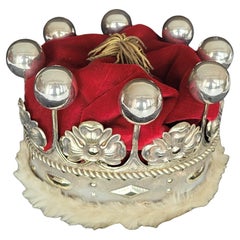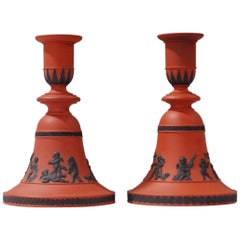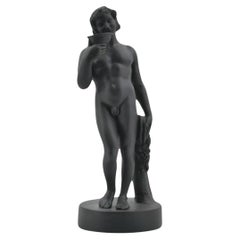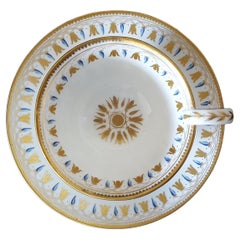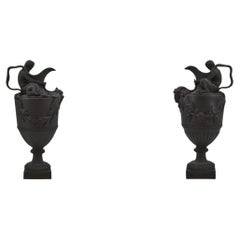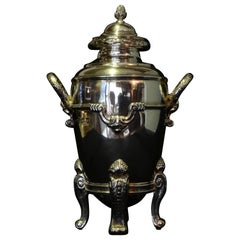Australia - Serveware, Ceramics, Silver and Glass
132
to
20
132
603
276
132
132
132
132
128
43
21
17
15
11
10
8
7
4
107
20
5
3
1
1
1
124
56
45
17
5
131
126
118
3
2
37
23
11
3
2
Item Ships From: Australia
Style: Neoclassical
Earl's Coronet, in Silver-Gilt with Ermine and Velvet, Hunt & Roskell, 1911
Located in Melbourne, Victoria
An Earl’s Coronet, in silver-gilt, by Hunt & Roskell: the firm formerly known as Storr & Mortimer, a direct line to Paul Storr. Made in 1911, no doubt for...
Category
Early 20th Century British Neoclassical Australia - Serveware, Ceramics, Silver and Glass
Materials
Sterling Silver
Pair of Rosso Antico Candlesticks, Wedgwood, circa 1820
By Wedgwood
Located in Melbourne, Victoria
A rare pair of bell shaped candlesticks in rosso antico, with black decoration of ‘Boys at Play’.
Category
Early 19th Century English Neoclassical Antique Australia - Serveware, Ceramics, Silver and Glass
Materials
Stoneware
Black basalt figure of Bacchus. Wedgwood C1780.
By Wedgwood
Located in Melbourne, Victoria
Exceptionally rare early figure of Bacchus in black basalt. The mixed-case mark places this figure between 1780 and 1785.
He is portrayed in typical style, his head garlanded with grapes and with a wine cup to his lips.
Bacchus, also known as Dionysus in Greek mythology, is the enigmatic god of wine, fertility, and ritual madness. He symbolizes freedom, ecstasy, and the blurring of societal norms through his rituals and festivities. Bacchus is often depicted in myths as a deity who challenges the status quo, promoting an atmosphere where conventional rules do not apply, and his followers are liberated from their everyday constraints.
Born from Zeus and the mortal Semele, Bacchus is unique among gods, bridging the divide between the divine and the human. His followers included the wild and ecstatic maenads, female devotees who often reached states of divine frenzy, and the satyrs, mischievous half-man, half-goat beings. The worship of Bacchus was marked by theatrical processions, dances, and plays, reflecting his patronage of the theater and the dramatic arts.
Bacchus’s mythology...
Category
1780s English Neoclassical Antique Australia - Serveware, Ceramics, Silver and Glass
Materials
Stoneware
Cup & Saucer decorated with bluebells. Nantgarw C1815.
By Nantgarw China Works
Located in Melbourne, Victoria
A particularly pleasing and restrained form of decoration for this period, which allows the beauty of the porcelain to be clearly seen.
Nantgarw porcelain is particularly fine, and ...
Category
1810s Welsh Neoclassical Antique Australia - Serveware, Ceramics, Silver and Glass
Materials
Porcelain
Pair of Flaxman Ewers in Black Basalt. Wedgwood C1830.
By Wedgwood
Located in Melbourne, Victoria
One of the iconic early wedgwood pieces, the pair of ewers Sacred to Neptune & Sacred to Bacchus was designed by Flaxman in the 1780s for Josiah Wedgwood. They have remained popular ...
Category
Early 19th Century English Neoclassical Antique Australia - Serveware, Ceramics, Silver and Glass
Materials
Stoneware
Neoclassical tea canister in sterling silver. Elkington 1929.
By Elkington & Co.
Located in Melbourne, Victoria
A splendid tea canister the neoclassical style, by Elkington, one of the best of teh English silversmiths of the period. The work is deep, crisp and detailed, and the item is in exce...
Category
Early 20th Century British Neoclassical Australia - Serveware, Ceramics, Silver and Glass
Materials
Sterling Silver
Campana Vase, Victoriaware Wedgwood, circa 1880
By Wedgwood
Located in Melbourne, Victoria
A campana vase in white & gilt Victoriaware. Very French in style, the decoration being a copy of Sevres. It works surprisingly well on the neoclassical shape.
Category
Mid-19th Century English Neoclassical Antique Australia - Serveware, Ceramics, Silver and Glass
Materials
Stoneware
English Delft Campana Vase, C1760
Located in Melbourne, Victoria
A rare, large vase in a classical shape, decorated with figures in a landscape. Large pieces of delftware are not often found.
See CIRC 43-1963 in the V&A for a similar example.
Category
Mid-18th Century English Neoclassical Antique Australia - Serveware, Ceramics, Silver and Glass
Materials
Earthenware
Large Dish or tureen stand, Chelsea, circa 1755
By Chelsea Porcelain
Located in Melbourne, Victoria
A fine tureen stand, typically painted with flowers and insects in the style of Meissen. A large and impressive piece.
Stilt marks and ground footrim.
Category
Mid-18th Century English Neoclassical Antique Australia - Serveware, Ceramics, Silver and Glass
Materials
Porcelain
Delft plate with a woman passing a monument. England C1745.
Located in Melbourne, Victoria
Tin-glazed earthenware, decorated with a woman in a landscape. Known as a monument plate, after the monument surmounted by a vase.
Prov: Troy Chappell c...
Category
Mid-18th Century English Neoclassical Antique Australia - Serveware, Ceramics, Silver and Glass
Materials
Earthenware
Delft plate - Ship in sail off the coast. Glasgow C1760
Located in Melbourne, Victoria
A dinner-plate, painted in the delft style, with a ship coming to land; bunches of grapes around the edge.
See Michael Archer, Delftwarem m233 no B258 for a similar example, which h...
Category
Mid-18th Century Scottish Neoclassical Antique Australia - Serveware, Ceramics, Silver and Glass
Materials
Earthenware
Encaustic Painted Basalt Vase, Wedgwood, circa 1770
By Wedgwood
Located in Melbourne, Victoria
A fine, large vase in black basalt, decorated with an en grisaille painted illustration of Orpheus playing his lyre, with a stag sitting quietly by, listening to his playing - and perhaps singing, although his mouth is shown closed.
Orpheus's talent on the lyre is one of the most celebrated aspects of his mythological character. In Greek mythology, Orpheus is renowned as a musician without equal, possessing a skillful mastery of the lyre, a stringed instrument similar to a small harp...
Category
Late 18th Century English Neoclassical Antique Australia - Serveware, Ceramics, Silver and Glass
Materials
Stoneware
Black Basalt and Gilt Vestal Lamp, Wedgwood, circa 1800
By Wedgwood
Located in Melbourne, Victoria
An oil lamp in basalt with rare gilt and bronze highlights.
This example is an early one, and was intended to be used. There is a 'sump cover' inside the lamp, which seals the po...
Category
Early 1800s English Neoclassical Antique Australia - Serveware, Ceramics, Silver and Glass
Materials
Stoneware
Delft plate witha couple leaving a church. Wincanton/London England C1750
Located in Melbourne, Victoria
A dinner-plate, painted in the delft style with a couple leacing a church, or perhaps a house. Wincanton pottery, or perhaps London.
English Delftware is considered to be one of the...
Category
Mid-18th Century English Neoclassical Antique Australia - Serveware, Ceramics, Silver and Glass
Materials
Earthenware
Tall coffee pot in pearlware, House & Fence decoration. C1790
Located in Melbourne, Victoria
A fine and large - enormous - coffee or chocolate pot in pearlware, with “House & Fence” decoration, in imitation of a Chinese original.
It is thought that these oversixed pots wer...
Category
Late 18th Century English Neoclassical Antique Australia - Serveware, Ceramics, Silver and Glass
Materials
Earthenware
Anglo-Irish Prussian-shaped Decanter, C1820
Located in Melbourne, Victoria
A fine and useful decanter, Prussian shape, of blown glass with prism cutting typical of the period; along with fluting and lens cutting. There can be no doubt this is the original s...
Category
Early 19th Century British Neoclassical Antique Australia - Serveware, Ceramics, Silver and Glass
Materials
Blown Glass
Engraved Warmbrunn wine glass with gilt rim. Silesia C1720.
Located in Melbourne, Victoria
A gorgeous conical wine glass with elaborate engraving encompassing a monogram below a crown, and a gilt rim.
Warmbrunn glass, also known as Warmbrunner glass, refers to a type of ...
Category
Early 18th Century German Neoclassical Antique Australia - Serveware, Ceramics, Silver and Glass
Materials
Blown Glass
Rare 'Hope Service' Plate 18th Century Flight Worcester
By Flight Worcester
Located in Brisbane, QLD
The Hope Service was designed and created by the Royal Flight Worcester Company, commissioned by the Duke of Clarence and St Andrews (later King William I...
Category
1780s English Neoclassical Antique Australia - Serveware, Ceramics, Silver and Glass
Materials
Porcelain
Wedgwood 'Dancing Hours' Black Jasper Centrepiece Bowl
By Wedgwood
Located in Brisbane, QLD
A fine black jasper-ware bowl crafted by Wedgwood in a design known as the 'Dancing Hours'. The black basalt wash over white jasper piece dates to the 1950s and has been handmade in ...
Category
Mid-20th Century English Neoclassical Australia - Serveware, Ceramics, Silver and Glass
Materials
Ceramic
Encaustic Painted Basalt Vase, Wedgwood, circa 1780
By Wedgwood
Located in Melbourne, Victoria
A fine, large vase in black basalt, decorated with an encaustic painted figure of a youth and an older man, taken from The Hamilton vase in the British Museum. It is unusual to find ...
Category
Late 18th Century English Neoclassical Antique Australia - Serveware, Ceramics, Silver and Glass
Materials
Stoneware
A Nun, perhaps a theatrical figure. England, probably Plymouth, circa 1750
By Plymouth Porcelain Factory 1
Located in Melbourne, Victoria
An interesting soft-paste porcelain figure of a Dominican Nun, perhaps the theatrical figure Heloise.
Although the Nun appears in various versions in European and English porcelain,...
Category
Mid-18th Century English Neoclassical Antique Australia - Serveware, Ceramics, Silver and Glass
Materials
Porcelain
Pair of Bacchantes in Black Basalt. Wedgwood C1860.
By Wedgwood
Located in Melbourne, Victoria
Perhaps the most complex work in black basalt undertaken on any scale by Wedgwood, the Bacchantes, are adapted from sculptures by Clodion. A large and impressive pair, ful of vigour ...
Category
Mid-19th Century English Neoclassical Antique Australia - Serveware, Ceramics, Silver and Glass
Materials
Stoneware
First Edition Portland Vase, Wedgwood, circa 1793
By Wedgwood
Located in Melbourne, Victoria
NOTE: We do not keep this in the showroom. Please let us know if you're visiting and would like to see it.
Rarely does a first edition Portland vase...
Category
Late 18th Century English Neoclassical Antique Australia - Serveware, Ceramics, Silver and Glass
Materials
Pottery
Small Teapot in Caneware with Spaniel Finial. Wedgwood, circa 1820
By Wedgwood
Located in Melbourne, Victoria
An unglazed caneware teapot of depressed oval shape, with arabesque decoration and a spaniel finial.
Wedgwood caneware is a type of pottery that w...
Category
1820s English Neoclassical Antique Australia - Serveware, Ceramics, Silver and Glass
Materials
Stoneware
Portrait Medallions David Garrick & Sarah Siddons, Wedgwood, 19th Century
By Wedgwood
Located in Melbourne, Victoria
A matched pair of portrait medallions showing the famous actors Mr Garrick (C1830) and Mrs Siddons, (circa 1880). Framed as a pair, they work well together.
David Garrick and Sarah Siddons...
Category
Mid-19th Century English Neoclassical Antique Australia - Serveware, Ceramics, Silver and Glass
Materials
Pottery
Pair of Salts in Slate Blue Jasperware, Wedgwood, circa 1790
By Wedgwood
Located in Melbourne, Victoria
A pair of salt cellars in slate-blue jasperware, with inlaid rims. decorated with the Romantic Poor Maria and Maternal Affection by Lady Templetown, as well as a more classical Cupid's Triumph.
In the 1790s, salt cellars were an essential tableware item used in England for serving and consuming salt. A salt cellar is a small container, often made of silver, glass, or porcelain, used to hold salt at the dining table. These cellars were typically placed in the center of the table, within easy reach of diners. Salt was taken from the cellar...
Category
Late 18th Century English Neoclassical Antique Australia - Serveware, Ceramics, Silver and Glass
Materials
Stoneware
Encaustic Painted Basalt Vase, Wedgwood, circa 1800
By Wedgwood
Located in Melbourne, Victoria
A fine, large vase in black basalt, decorated with an encaustic painted figure of a youth, taken from The Hamilton vase in the British Museum.
The shape is taken from the Greek Hydria...
Category
Late 18th Century English Neoclassical Antique Australia - Serveware, Ceramics, Silver and Glass
Materials
Stoneware
Tea Cup & Saucer, Saint Cloud, circa 1730
By Saint Cloud
Located in Melbourne, Victoria
Both cup and saucer with moulded reeding and decorated in underglaze blue with scrolled lambrequin borders.
Saint Cloud porcelain is a type of soft-paste porcelain produced in the French town of Saint Cloud from the late 17th century to the mid-18th century. It was one of the earliest European attempts to produce porcelain and is known for its delicate, pale blue-gray glaze and simple, elegant designs.
The history of Saint Cloud porcelain can be traced back to the late 17th century when a group of Flemish potters settled in the town of Saint Cloud, which was then a royal estate...
Category
Early 18th Century French Neoclassical Antique Australia - Serveware, Ceramics, Silver and Glass
Materials
Porcelain
Sugar Box in Cobalt Jasperware, Adams, circa 1800
By Adams
Located in Melbourne, Victoria
A fabulous oval sugar box, with elaborate applied relief, engine turning, and a swan finial.
Impressed mark for Adams.
The Adams pottery company w...
Category
Late 18th Century English Neoclassical Antique Australia - Serveware, Ceramics, Silver and Glass
Materials
Pottery
Teapot, Fruitbasket, William Greatbatch, circa 1770
By William Greatbatch
Located in Melbourne, Victoria
A classic Greatbatch teapot, with ear-shaped handle, in the form of a fruit basket. The fruit basket was emblematic of hospitality, being full of rare, exotic items.
William Greatbatch...
Category
Late 18th Century English Neoclassical Antique Australia - Serveware, Ceramics, Silver and Glass
Materials
Creamware
Coffee Cup, Classical Ruins, Coloured: Worcester, Giles, circa 1770
By 1st Period Worcester Dr. Wall
Located in Melbourne, Victoria
Coffee cup and saucer, decorated with a Hancock type print in black overglaze, which has then been coloured with enamels and highlighted with gilt.
The decoration possibly James ...
Category
Late 18th Century English Neoclassical Antique Australia - Serveware, Ceramics, Silver and Glass
Materials
Porcelain
Salt Glaze Sauce Boat, Barley-Corn Pattern, English, circa 1755
Located in Melbourne, Victoria
An excellent example of the popular Barleycorn pattern, crisply moulded in panels to the sides, with graceful sprigs. Salt-glaze particularly suits this sort of fine relief.
Excel...
Category
Mid-18th Century English Neoclassical Antique Australia - Serveware, Ceramics, Silver and Glass
Materials
Stoneware
Australian Bicentenary Bowl, Wedgwood, circa 1988. Number 10 of 50 Made
By Wedgwood
Located in Melbourne, Victoria
In Royal Blue dip; a colour normally reserved for Coronation commemoratives. One of only fifty made; made to mark the bicentenary of the found...
Category
1980s English Neoclassical Vintage Australia - Serveware, Ceramics, Silver and Glass
Materials
Stoneware
Encaustic Painted Ecuelle, Wedgwood, circa 1790
By Wedgwood
Located in Melbourne, Victoria
In black basalt, decorated with encaustic painting.
An écuelle is a French word that refers to a shallow dish or bowl, typically made of metal or ceramic, and used for serving food. Écuelle is also the French word for a small, shallow saucer used for serving soup. In English, an écuelle might be referred to as a soup plate or a soup saucer...
Category
1780s English Neoclassical Antique Australia - Serveware, Ceramics, Silver and Glass
Materials
Stoneware
Jasperware Buckle, Wedgwood, Matthew Boulton, Circa 1795
By Wedgwood
Located in Melbourne, Victoria
A jasper medallion decorated with Aphrodite, set in cut steel as a buckle, probably by Matthew Boulton. Original box.
The Greek goddess Aphrodite is often depicted in ancient art with a dolphin. In mythology, dolphins were considered sacred to Aphrodite, and they were associated with love, beauty, and fertility. According to one legend, Aphrodite emerged from the sea on a shell-borne chariot drawn by dolphins, and the creatures were said to be her faithful servants. As a result, images of Aphrodite with dolphins became a popular motif in Greek art, appearing on vases, sculptures, and other decorative objects. The association between Aphrodite and dolphins has continued through the centuries, and the image of the goddess with a dolphin remains a popular symbol of love and beauty.
Matthew Boulton (1728-1809) was an English manufacturer and entrepreneur who was best known for his contributions to the Industrial Revolution...
Category
Mid-19th Century English Neoclassical Antique Australia - Serveware, Ceramics, Silver and Glass
Materials
Cut Steel
Wedding Plate in cremware, Wedgwood C1786
By Wedgwood
Located in Melbourne, Victoria
A creamware plate, with transfer printed decoration. From a service probably ordered to commemorate the wedding of John Peter and Ann Du Port, of Guernsey.
The plate is of plain cre...
Category
Late 18th Century English Neoclassical Antique Australia - Serveware, Ceramics, Silver and Glass
Materials
Creamware
Dated Creamware Punch Bowl, Leeds, 1787
By Leeds Pottery
Located in Melbourne, Victoria
A documentary punch bowl, decorated with transfer prints and enameling, dated and inscribed for D. Walker. Unmarked, but this class of dated creamware with enameled prints belongs to...
Category
Late 18th Century English Neoclassical Antique Australia - Serveware, Ceramics, Silver and Glass
Materials
Earthenware
Encaustic Painted Cup and Saucer in Black Basalt, Wedgwood C1790
By Wedgwood
Located in Melbourne, Victoria
Black basalt, with rope handle and encaustic decoration of lines & anthemion, in imitation of early Greek pottery. Early encaustic examples are rar...
Category
Late 18th Century English Neoclassical Antique Australia - Serveware, Ceramics, Silver and Glass
Materials
Stoneware
Figure of a Nun, Perhaps Heloise, Bow Porcelain Factory, circa 1750
By Bow Porcelain
Located in Melbourne, Victoria
A classic example of early bow porcelain.
The figure is of a Dominican Nun, and is based on a continental model, probably Meissen.
Bow produced a number of apparently religious...
Category
Mid-18th Century English Neoclassical Antique Australia - Serveware, Ceramics, Silver and Glass
Materials
Porcelain
Bust of Sir Isaac Newton, Pearlware, Ralph & Enoch Wood, circa 1790
By Ralph Wood Pottery
Located in Melbourne, Victoria
A pearlware bust of Sir Isaac Newton, by Enoch Wood. The oak pedestal adds dignity to an attractive rendering of this great man of science. A handwrit...
Category
Late 18th Century English Neoclassical Antique Australia - Serveware, Ceramics, Silver and Glass
Materials
Pearlware
Oval Dish, Chantilly, circa 1770
By Chantilly
Located in Melbourne, Victoria
Underplate from a tureen or similar; decorated with simple cobalt decoration.
The history of Chantilly porcelain can be traced back to around 17...
Category
Late 18th Century French Neoclassical Antique Australia - Serveware, Ceramics, Silver and Glass
Materials
Porcelain
Hot Milk Jug, Engine-Turned Jasperware. Wedgwood, C1785
By Wedgwood
Located in Melbourne, Victoria
Superb and exceptionally rare small jug in tricolour engine-turned diceware.
This is very early jasperware, made when "cherokee clay" was still being used. This clay, sourced from America, contained kaolin, the ingredient that makes porcelain translucent.
Exhibited: Wedgwood, Master Potter to the Universe, Roche Foundation, 2023.
Engine turning, also known as guilloche, is a decorative technique that was commonly used on eighteenth-century pottery. The process involved cutting intricate, repetitive patterns into a metal or ceramic surface using a machine known as a rose engine...
Category
Late 18th Century English Neoclassical Antique Australia - Serveware, Ceramics, Silver and Glass
Materials
Stoneware
Pair of Black Basalt Reclining Figures, Cleopatra and Lucretia, Neale circa 1780
By Neale & Co.
Located in Melbourne, Victoria
A fine, rare pair of figures in black basalt from the Neale Manufactory. The Neale pottery was founded in 1778 and ran until around 1792. They made very fine wares, and were on good terms with Wedgwood, with whom they combined shipments to the continent.
For two similar figures marked for Neale & Co. see Diana Edwards, Black Basalt, Wedgwood and Contemporary Manufacturers, Suffolk, 1994, p. 208, figs. 313 & 314.
Cleopatra and Lucretia are two women from different time periods and historical contexts, but are linked by their importance in Roman history, as well as by their tragic ends.
Cleopatra was a famous queen of ancient Egypt, who ruled from 51-30 BC. She was the last pharaoh of Egypt and is remembered for her intelligence, beauty, and political savvy. Cleopatra was involved in a romantic relationship with the Roman general and statesman, Julius Caesar, and later with the Roman general and politician, Mark Antony...
Category
Late 18th Century English Neoclassical Antique Australia - Serveware, Ceramics, Silver and Glass
Materials
Stoneware
Teapot, Derby Porcelain Works, circa 1775
By Derby
Located in Melbourne, Victoria
A gadrooned, canon-ball shape teapot, decorated with typical sprays of natural flowers. The shape and decoration are both in imitation of Meissen.
The Derby Porcelain Works, now known as the Royal Crown Derby Porcelain Company, is a British manufacturer of fine bone china. The company has a long and rich history dating back to the late 18th century.
The company was founded in 1750 as the Derby China Works. It was originally located in the city of Derby and produced a wide range of ceramic wares, including tea sets, vases, and figurines. In 1756, the company was granted the status of "Supplier to the King," which allowed it to use the "Royal" designation in its name.
In the late 18th and early 19th centuries, the company experienced significant growth and expanded its product line to include more elaborate and ornate pieces. The company was particularly known for its "Derby Posies...
Category
Late 18th Century English Neoclassical Antique Australia - Serveware, Ceramics, Silver and Glass
Materials
Porcelain
Encaustic Painted Cup & Saucer, Wedgwood, circa 1820
By Wedgwood
Located in Melbourne, Victoria
A particularly fine example of a cup and saucer in the neoclassical style, simply decorated with a red line and a '"Leaf & Berry" motif.
The "leaf and berry" motif is a design element that is often found in neoclassical architecture and decorative arts. It features stylized leaves and berries arranged in a symmetrical pattern. This motif is commonly found on friezes, cornices, and other architectural elements, as well as on furniture, ceramics, and other decorative objects. It is associated with the neoclassical period, which began in the late 18th century and was characterized by a renewed interest in the classical art and architecture of ancient Greece and Rome...
Category
Early 19th Century English Neoclassical Antique Australia - Serveware, Ceramics, Silver and Glass
Materials
Stoneware
Waste Bowl, Chelsea, circa 1755
By Chelsea Porcelain
Located in Melbourne, Victoria
An unusual waste bowl (sometimes called a slop bowl) in soft-paste porcelain, decorated with typical Chelsea sprigs and bunches of flowers.
One of the most...
Category
Mid-18th Century English Neoclassical Antique Australia - Serveware, Ceramics, Silver and Glass
Materials
Porcelain
Tea Canister, Crimson Jasper, Wedgwood, circa 1920
By Wedgwood
Located in Melbourne, Victoria
Charming tea canister in the very rare crimson jasper dip. This example is particularly fine, and shows none of the usual problems that resulted in wedgwood abandoning this color after a short period.
Exhibited: Wedgwood, Master Potter to the Universe, Roche Foundation, 2023.
The Three Graces are a group of three female figures from Greek mythology who were considered to be the embodiment of charm, beauty, and grace. They were believed to be the daughters of Zeus and Eurynome and were known by the names of Aglaea, Euphrosyne, and Thalia. They were often depicted in ancient Greek art...
Category
Early 20th Century English Neoclassical Australia - Serveware, Ceramics, Silver and Glass
Materials
Stoneware
Magnum Decanter, England C1790 with Later Etched Masonic Decoration
Located in Melbourne, Victoria
A magnum decanter, made plain in Georgian times. Later etched for brandy, and decorated with Masonic symbols, in imitation of early wheel-cut engraving...
Category
Late 18th Century British Neoclassical Antique Australia - Serveware, Ceramics, Silver and Glass
Materials
Blown Glass
Tea Bowl & Saucer, Chelsea, circa 1752
By Chelsea Porcelain
Located in Melbourne, Victoria
An octagonal tea bowl and matching saucer, decorated with Chelsea's usual beautiful flower painting.
One of the most distinctive features of Chelsea porcelain is its intricate floral painting, which often featured detailed, lifelike renditions of flowers and other botanical subjects. The factory employed skilled artists who were trained in the art of flower painting, and the results have always been highly prized by collectors.
Chelsea porcelain is highly collectible and has a reputation for being of exceptional quality. It is often considered to be among the finest examples of English porcelain...
Category
Mid-18th Century English Neoclassical Antique Australia - Serveware, Ceramics, Silver and Glass
Materials
Porcelain
Seal, I Still Hope, Derby Porcelain Works, circa 1760
By Derby
Located in Melbourne, Victoria
A delightul porcelain seal, depicting a young lady, seated on a mound. It is painted with the motto J'ESPRE ENCORE, or I Still Hope. No doubt this was intended as a gift, to be given...
Category
Late 18th Century English Neoclassical Antique Australia - Serveware, Ceramics, Silver and Glass
Materials
Porcelain
Delft Charger, Coursing a Stag, English, circa 1710
Located in Melbourne, Victoria
Tin glazed earthenware (Delftware) dish, in an unusual shape; elaborately and skillfully painted with a man coursing a stag. Probably London; perhaps Bristol. Probably the salver for a large ewer.
English Delftware is considered to be one of the most important forms of English ceramic production of the period, and it had a major influence on the development of the British ceramics...
Category
Early 18th Century English Neoclassical Antique Australia - Serveware, Ceramics, Silver and Glass
Materials
Earthenware
Large Dish, Chelsea, circa 1755
By Chelsea Porcelain
Located in Melbourne, Victoria
A large platter, probably once associated with tureen. Beautiful flower painting, possible done outside the factory at the Giles studio in London, or perhaps at the Chelsea studio by a painter who had previously worked there. The tulip, heartease, and others look very Giles.
One of the most distinctive features of Chelsea porcelain is its intricate floral painting, which often featured detailed, lifelike renditions of flowers and other botanical subjects. The factory employed skilled artists who were trained in the art of flower...
Category
Mid-18th Century English Neoclassical Antique Australia - Serveware, Ceramics, Silver and Glass
Materials
Porcelain
Miniature Salt Glaze Jug, English, circa 1760
Located in Melbourne, Victoria
A charming, small jug in salt-glazed earthenware. Plain: just the way we like it.
Category
Mid-18th Century English Neoclassical Antique Australia - Serveware, Ceramics, Silver and Glass
Materials
Stoneware
Miniature Salt Glaze teapot, English, circa 1760
Located in Melbourne, Victoria
A fine, one-cup teapot in undecorated salt-glazed earthenware. The size reflects the early custom of a pot to each tea drinker.
Category
Mid-18th Century English Neoclassical Antique Australia - Serveware, Ceramics, Silver and Glass
Materials
Stoneware
Saucer Dish, "Milkmaids" Pattern with Double Rebus, Worcester, circa 1757
By 1st Period Worcester Dr. Wall
Located in Melbourne, Victoria
Transfer print decoration of The Milkmaids.
The engraving carries marks for three important people, and is very rare.
The double-anchor represent the Holdship brothers, Richard...
Category
Mid-18th Century English Neoclassical Antique Australia - Serveware, Ceramics, Silver and Glass
Materials
Porcelain
Saltglaze Pounce Pot, English, circa 1750
Located in Melbourne, Victoria
A charming pounce pot, or sander, in sale-glazed earthenware. Unusually good condition. These were used to sprinkle pounce on writing paper; pounce was powd...
Category
Mid-18th Century English Neoclassical Antique Australia - Serveware, Ceramics, Silver and Glass
Materials
Stoneware
Teapot Stand, "Milkmaids" Pattern, Worcester, circa 1760
By 1st Period Worcester Dr. Wall
Located in Melbourne, Victoria
Hexagonal teapot stand, with transfer print decoration of The Milkmaids.
From an engraving by Richard Hancock, one the best and most important of the en...
Category
Mid-18th Century English Neoclassical Antique Australia - Serveware, Ceramics, Silver and Glass
Materials
Porcelain
Plate with Coiled Phoenix, Chelsea, C1754
By Chelsea Porcelain
Located in Melbourne, Victoria
A very fine plate, damasked with Gotzkowsky erhaben Blumen. Decorated after the Japanese with peonies and a coiled phoenix to the centre, using the Kakiemo...
Category
Mid-18th Century English Neoclassical Antique Australia - Serveware, Ceramics, Silver and Glass
Materials
Porcelain
Recently Viewed
View AllMore Ways To Browse
Hermes Dining Table
Silver Tea Service Tray
Antique Silver Sugar And Creamer Set
Chinese Coffee Set
19th Century Silver Tea Service
Tea Set Made In China
Lighted Vintage Glass Bottles
Silver Teapot Creamer
Vintage Tea Stand
Vintage Tea Stands
Antique Teapot Designs
Bottle Stopper Crystal
Antique Furniture Hire
Three Piece Silver Tea Set
English Tea Bowl
Vintage Tea Maker
Cobalt Blue Glass Table
Small Flower Pot
